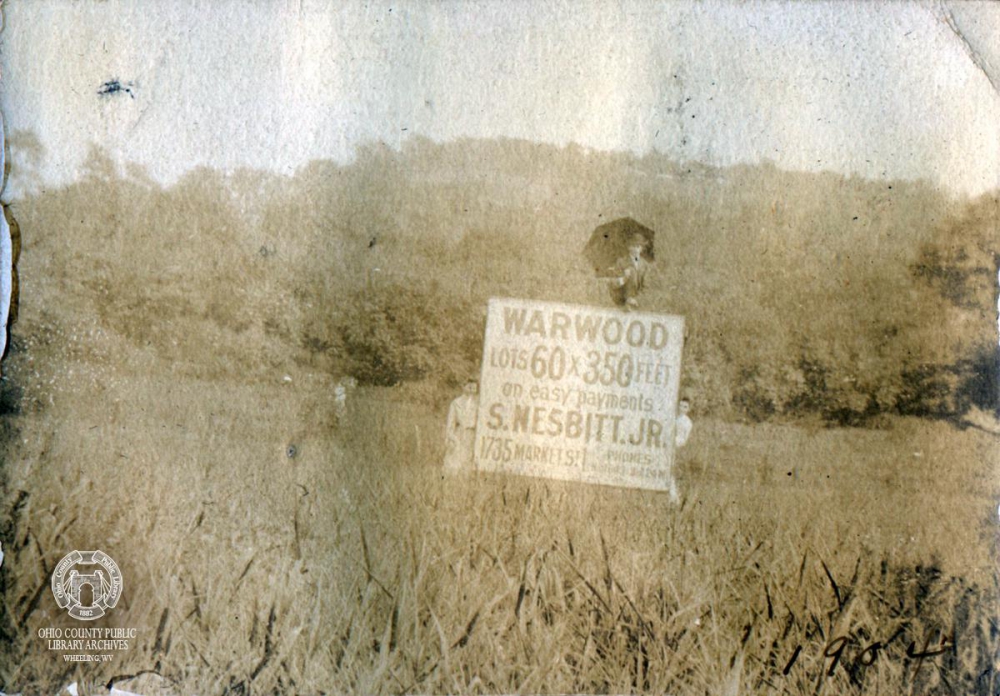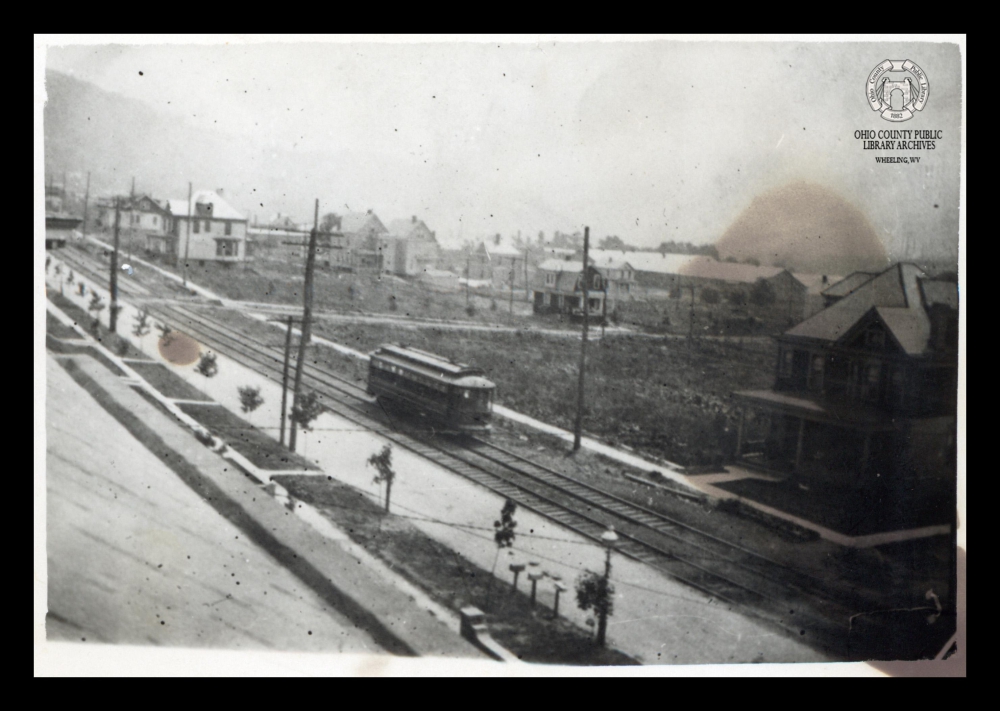
Warwood
Warwood Quick Links
➤ History | ➤ Location | ➤ Images | ➤ Additional Resources
Warwood Quick Links
Warwood Neighborhood In Wheeling
Famous Residents:
➤ Chuck Howley (Hall of Fame Football Player)
➤ Eleanor Steber (Internationally Famed Opera Star)
(text by Dr. Charles Julian)
At the cusp of the 20th Century, the section of Wheeling now known as Warwood was devoid of densely populated regions and composed primarily of expansive truck gardens/farms and estates owned by the area’s first families: Culbertson, Dewey, Dorsch, Ebert, Garden, Kercher, Lash/Lasch, Myers, Riley/Reilly, Stenger, and others.
Before incorporation as the town of Warwood, the land located within the Richland Magisterial District included Glenova (named in honor of Thomas Glenn, the area’s first resident), Richland (sometimes referred to as Warwood or Center Warwood), and Loveland. Although many speculate that the town of Warwood was named after Henry Warwood (the founder of the Warwood Tool Company, see page 31) the locality was named and incorporated after Henry retired and left Martins Ferry, Ohio in 1892 for Brooklyn, New York to reside with his daughter Emily. It’s unlikely that Henry Warwood ever had any connection with the town across the river from his factory.
In March 1904, the Wheeling News-Register reported that the Warwood Land Company had incorporated, and its directors included: R.J. McCullagh, John M. Brown, Dr. John L. Dickey, Ferdinand Wingerter, Dr. C.A. Wingerter, James W. Ewing, and S. Nesbitt, Jr. Robert J. McCullagh was appointed Treasurer and General Manager and for his efforts is commonly referred to as the “Father of Warwood.” Realtor Samuel L. Nesbitt, Jr. often worked with McCullagh selling Warwood Land Company lots. McCullagh was responsible for the purchase of over 127 acres eventually divided into five sections then subdivided into lots made available for sale at reasonable rates.
It is likely that McCullagh (or his business associates) cultivated connections with the owners of Warwood Tool Company, who in 1892, relocated their business from Martins Ferry, Ohio to South Wheeling (either Daniel L. Heiskell or Benjamin Walker Peterson). In 1903, Warwood Tool Company purchased seven acres of land from the Garden estate property to relocate its plant and in July 1904, McCullagh submitted a real estate plat of Warwood (the first official geographic use of the name “Warwood”). Warwood Tool held a groundbreaking ceremony on May 22, 1904 and operations began in its new Warwood plant in 1905.
Immediately to the south of the Warwood Land Company’s property, the section of Loveland was developed. Marketed by the Loveland Improvement Company (incorporated in 1905), Loveland lots were promoted aggressively and included reasonable financing plans. Eventually the company sold completed houses on their lots and significant quality-of-life enhancements were developed by the company (water, gas, electric lights, sidewalks, schools, parks, etc.). The Company ceased operations in the mid-1920s.
Other areas contiguous to the two companies’ site were marketed by smaller real estate companies/developers and within a decade many residences had developed in the new community and grown up around the Warwood Tool Company. Glenova, Warwood, and Loveland each were self-governed municipal entities responsible for providing education, public safety, public works, and other local amenities/civic improvements. However, eventually it just made sense that the contiguous areas should merge and consolidate their efforts to the ultimate benefit of citizens.
In January 1910, the local newspaper reported that residents of Loveland and South Warwood would vote on the issue of incorporating both contiguous areas and that the incorporated town’s name would be “Woodsboro.” It was presumed that residents of “Warwood proper” would be resistant to incorporation so the Loveland and South Warwood citizens proceeded with their incorporation procedures. The first step was an election to vote on incorporation of Woodsboro that was scheduled for February 10, 1910.
The citizens agreed to the incorporation of the two contiguous areas but encountered significant and prolonged opposition from important foes including large property owners, the Richland Coal Company, and the Pennsylvania Railroad. Several elections were held and contested and ultimately all three areas (Glenova, Warwood, and Loveland) voted on incorporation and the measure was approved. That election was contested in Circuit Court and the opposition won again on a legal technicality (a more current census was required). Officials conducted the appropriate census, held a final election in May 1911, and approval of incorporation passed by a majority of ninety votes. Judge Frank W. Nesbitt approved the Certificate of Incorporation and the town of Warwood officially was born on May 26, 1911.
June 27, 1911, the first Warwood municipal election was held. The Citizen Party candidates were swept into power and Dr. James William Abercrombie was elected the first Mayor. From 1911-1920, six men served as Warwood Mayor: Dr. Abercrombie, Charles Harris Dowler, Harry Charles Fuhr, William Edmund Helfenbine, Herman August Kindelberger, and John Herbert Montgomery. Dowler and Kindelberger each served 3 terms as Mayor. Dowler’s final Mayoral term was intended to cease in 1919 when Wheeling citizens approved the Greater Wheeling proposal (which included annexation of Warwood and other area suburbs). However, subsequent litigation delayed implementation until early 1920. Dowler and other Warwood councilors served extended terms until February 1920 when Warwood officially became a part of the City of Wheeling.
In 1907, Warwood had 3,000 inhabitants and by 1935 the population had grown to 7,000. Real estate sold well in the area, which was promoted for its pure drinking water, excellent utilities, number of churches, good schools, fine transportation (streetcar and railroad), location above flood zones, strong industrial base/good jobs, and better natural advantages. The community’s slogan was “Warwood: Watch Us Grow!” The successful realization of the catchy slogan was the result of the growth and development of business and industries, civic and public-spirited citizens, individual achievement, organizational influence, and enhanced quality of life. Throughout the first half of the 20th Century, Warwood was an attractive and fulfilling place to live.
Location
➤
Additional Resources
Materials in the Library's Wheeling Room: non-circulating, ask at Reference Desk for access.
➤Warwood A History by MABEL HINRICHS BISSETT & BERTHA CUPP JONES. Edited & published by Ernest St. C. Bentfield, 1993.
➤ Part I
➤ Part II
➤ Part III
➤ Part IV
➤ Vertical File: [Wheeling Neighborhoods] Warwood.
➤ Warwood Walking Tour (Wheeling Heritage)
➤ Julian, C., Warwood: The Evolution of Watch Us Grow -Upper Ohio Valley Historical Review
➤ Wickham's Store (Archiving Wheeling by S. Duffy)
➤ Warwood's Coney Island Amusement Park (Archiving Wheeling by S Duffy)
➤ Warwood High School
This document was last modified .
-Information on this page compiled by sduffy











